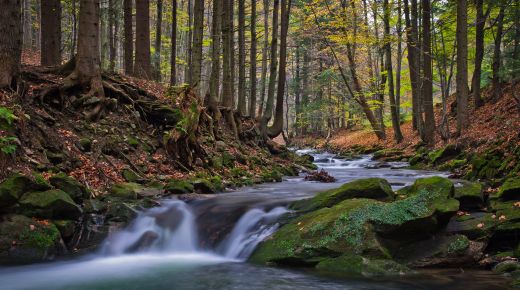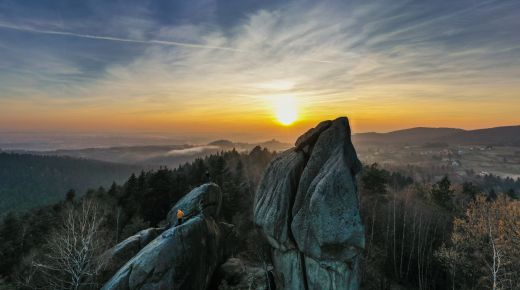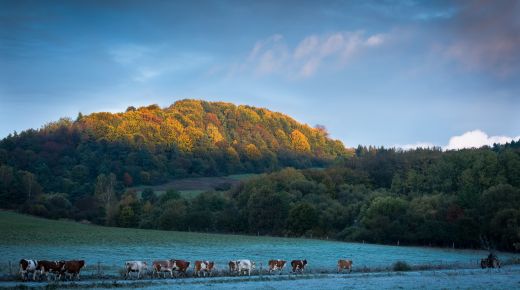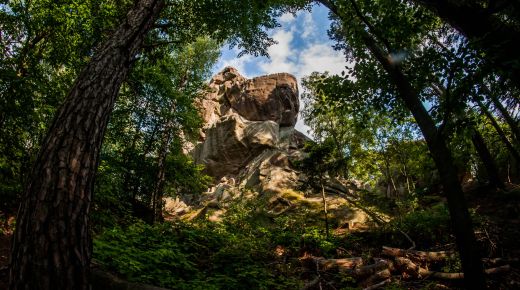The Low Beskids is the wildest mountain range in Poland. The richness and natural peculiarities of this corner have made it home to many protected sites
![Krajobraz Beskidu Niskiego - Przełęcz Szklarska - widok na Cergową zachód słońća.webp [350.59 KB]](https://podkarpackie.travel/storage/image/core_files/2023/4/25/5951d8e65e8046772c9946c0ef6cb1eb/webp/prot/preview/Krajobraz%20Beskidu%20Niskiego%20-%20Przełęcz%20Szklarska%20-%20widok%20na%20Cergową%20zachód%20słońća.webp)
![Wojciech_Buła_Magurski_Park_Narodowy_6452.webp [792.39 KB]](https://podkarpackie.travel/storage/image/core_files/2023/4/25/60d6bb39dd870cc4dee6d10f5bfffc33/webp/prot/preview/Wojciech_Buła_Magurski_Park_Narodowy_6452.webp)
In the Magura National Park, lovers of forest hiking, amateurs of hugging trees - will feel like a fish in water. This is because most of its area is occupied by forests - it is the most forested national park in Poland. On its territory there are three strict protection areas, where nature is unfettered, places where man cannot interfere - Magura Wątkowska, Kamień and Zimna Woda. If you're lucky, wandering along untrodden forest paths and trails, among the nearly 140 species of birds that live here, you can meet and hear the lesser spotted eagle - a symbol of the park. Rare species of wilderness animals - including lynx, wildcat and elk - have also found refuge in the richness of the local flora.
If you're lucky, wandering along untrodden forest paths and trails, among the nearly 140 species of birds that live here, you can meet and hear the lesser spotted eagle - a symbol of the park. Rare species of wilderness animals - including lynx, wildcat and elk - have also found refuge in the richness of the local flora.
In the northern part of the park runs the Main Beskid Trail, which, depending on the direction you choose, will lead you to Ustroń in the Silesian Beskid or Wolosaty in the Bieszczady Mountains. There are more than 100 km of this trail through the Low Beskids! On the other hand, on the slope of Mount Kosma (black trail) you can find the Devil's Stone natural monument, and the long legend with a devil's twist is worth learning already during the hike. However, the nooks and crannies of the dense primeval forest hide something else - the largest, almost 7-meter high waterfall of the Low Beskid - Magura Waterfall.
![Beskid Folusz 1.webp [706.47 KB]](https://podkarpackie.travel/storage/image/core_files/2023/4/25/37bfee27cfd22cf75f789e6ca214bdb4/webp/prot/preview/Beskid%20Folusz%201.webp)
![Beskid Cergowa Wieża 3.webp [624.81 KB]](https://podkarpackie.travel/storage/image/core_files/2023/4/25/f947c00c23b70ac577618b71f837ab4e/webp/prot/preview/Beskid%20Cergowa%20Wieża%203.webp)
Those looking for breathtaking scenery, will certainly enjoy the viewing tower on Cergowa and the Wysokie peak, where one can admire the Beskid valleys stretching below with Magura sandstone outcroppings, the gorges of the Jasiolka and Wislok rivers, where once - in the Lemko villages that no longer exist - life was vibrant. Numerous traces of the villages remain from those times - wooden Orthodox churches or abandoned chapels adorning the landscape, cemeteries and churchyards boosting the aura of mystery.
In a break from hiking, it is worth visiting the Education Center of the Magura National Park in Krempna, with an exhibition hall and multimedia show presenting the park's nature in four seasons. During your visit, you can learn about all the species characteristic of the region, as well as how the Carpathian flysch - layers of alternating sedimentary rocks that are highlighted during hikes in the Low Beskid - was formed over millions of years.
Read more about Magura National Park Educational Center in Krempna
In the green corners of the Low Beskid - the kingdom of wildlife - there are also other forms of protection, such as: Jaśliska Landscape Park or the largest in this part of the Carpathians - the Jasiołka Springs Reserve - is also worth noting because of the Lemko village Jasiel, once located on its territory, marked by a difficult and bloody history. Nowadays, the former settlement is evidenced by an Orthodox church, a churchyard cemetery and several roadside crosses.
See also:
Czarnorzeki-Strzyżów Landscape Park
USEFUL INFORMATION
Magura National Park
Krempna 59, 38–232 Krempna
tel.: +48 13 441 40 99, +48 13 441 44 40, +48 660 105 524
Educational Center of the Magura National Park in Krempna
Opening dates and times:
November-April
Monday: closed
Tuesday-Friday: 7:00–15:00
Saturdays, Sundays and holidays: closed
May-October
Monday: closed
Tuesday-Friday: 7:00–17:00
Saturdays, Sundays and holidays: 9:00–17:00
Complex of Landscape Parks in Krosno
8a Trakt Węgierski Street, 38-450 Dukla
tel. +48 13 436 31 87
e-mail: poczta@parkikrosno.pl
Opening dates and times:
Monday–Friday: 7:00–15:00
Parks:
Jaśliska Landscape Park
Czarnorzecko-Strzyżowski Landscape Park
Nature Reserves:
"Yews in Mogilno","Jelenia Góra","Kornuty","Łysa Góra","Wadernik","Igiełki","Modrzyna", "Yews in Nowa Wieś", "Reserve of the Millennium on Cergowa Góra","Jasiołka Gorge","Kamień nad Jaśliska", "Źródliska Jasiołki","Bukowica"and "Kamień nad Rzepedzią".
Natura 2000 area: "Ostoja Magurska", "Ostoja Jaśliska", "Łysa Góra", "Źródliska Wisłoki", "Rymanów", "Trzciana", "Osuwiska w Lipowicy", "Jasiołka" and the bird sanctuary "Low Beskids".





